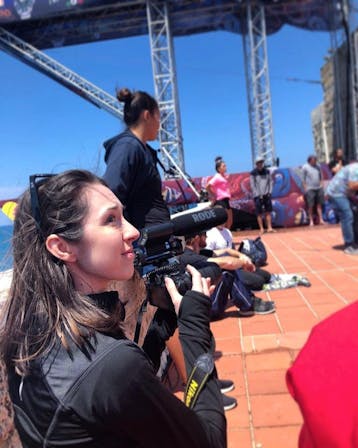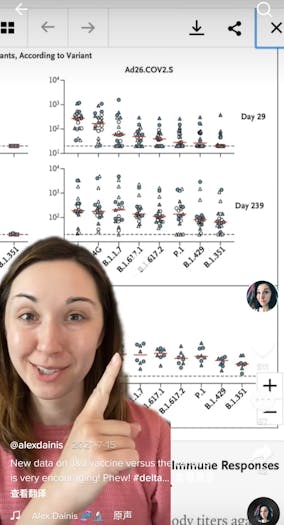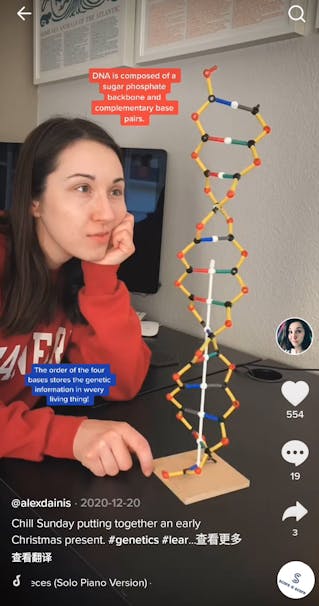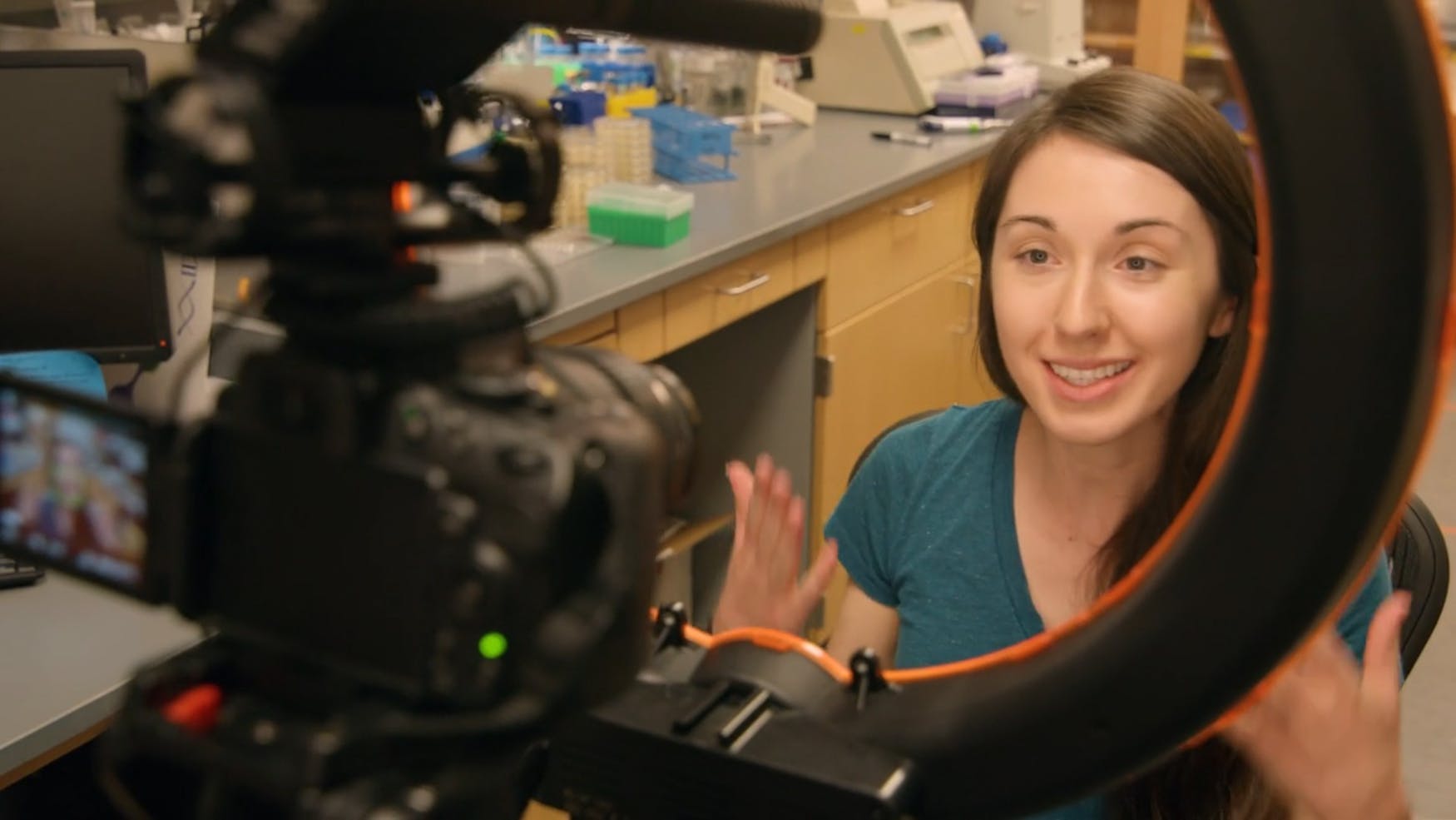From the lab bench to the For You page
Alex Dainis ’11 spoke to the Justice on March 18 about her journey from biology and film student, to unexpected viral sensation, to full-time science content creator.
The year was 2019. Alex Dainis ’11 had just graduated from Stanford University with a doctorate degree in genetics. Many of her peers stayed in academia to continue their research, and others joined the biotech industry. Instead of taking one of those traditional paths, Alex took a leap of faith and started making science videos on YouTube full-time. She also started her own video production company and named it, in classic biology nerd fashion, Helicase Media, after a protein essential for DNA replication in cells. At this point, she had been making science videos on YouTube since 2012, a year after she graduated from Brandeis. Now, she just needed to make it a real job.
Alex first started to take an interest in science when she was a child. Her dad is an engineer, and her mom is very fond of gardening and the outdoors. She spent her childhood watching her dad apply science through his engineering work and getting what she calls “hands-on biology experience” from gardening with her mom. By the time she was applying to college, her heart was set on biology. She received the merit-based Justice Brandeis Scholarship and started attending Brandeis in 2007, where she studied biology as she’d planned. She worked in the Garrity Lab, where she discovered her passion for biological research. But this wasn’t the only subject she explored her passion for during her time at Brandeis: Alex graduated in 2011 with a major in Biology and a minor in Film, TV, and Interactive Media.
Alex’s interest in filmmaking started much later than her interest in science, but it became crucial in her quest to become a professional online science content creator. In high school, she got a point-and-shoot camera and started making short videos to upload onto YouTube. They got only around 20 views and according to Alex, “None of them were good, all of them were terrible.” This was in the early days of YouTube, when most of the content on the site was casual, low-effort videos made in peoples’ bedrooms, the 2000s equivalent of high schoolers making dance videos on TikTok today. Most of Alex’s early videos were in the same category as the rest of the platform, but her videos are no longer available online, except for the one that started her crazy journey towards becoming a full-time science educator on the internet.
After graduating from Brandeis in 2011, Alex worked for Richard Lewis Media Group, a film production company in Watertown making interactive science media for museums, before starting at Stanford in 2013. During her time at the company, she posted a video of herself lip-syncing to early-2000s teen heartthrob Aaron Carter's “Aaron's Party (Come Get It)” over the span of six years. A reporter at HuffPost wrote an article about the video the day after it was published, and the video has since received over 300,000 views. That video led to an influx of viewers and subscribers on Alex’s YouTube channel. “I was like, ‘What do I now do with these thousands of viewers that I suddenly have?’” Though this new audience had found Alex through her funny lip-syncing, she used the opportunity to take her channel in a very different direction.
“They were all expecting silly lip-sync videos and I decided to give them science videos,” said Alex. She started a video series called “Bite Sci-zed,” a collection of educational videos that uncover the science behind things we see in our daily lives. For example: how does a match light on fire? Or how did humans create a seedless watermelon with genetics? Her videos started to receive more and more views, but she did not dream of making any real money from YouTube. “I really didn't know at that time that I could make a career out of doing this myself and out of producing these videos myself, it was just a fun thing,” Alex said.

GETTING THE SHOT: Alex sets up the camera for a video.
Alex has moved on from her “Bite Sci-zed” video series, but she didn’t stop making educational science videos on YouTube, creating various series such as “Lab Next Door” and “What is this Thing?!” For her “Lab Next Door” videos, Alex visited different labs to talk to scientists from a variety of fields about their work, including a NASA astronaut – “They let me talk to an astronaut!” she exclaims at the start of the video. In her “What is this Thing?!” series, she introduces viewers to various equipment that can be found in science labs.
“[Science is] something that touches all of our lives every day,” said Alex, explaining how we see non-genetically modified produce on the shelf at grocery stores, hear about “CRISPR” gene editing on the news, and can easily purchase mail-in DNA ancestry tests on the internet. Science is all around us, whether we realize it or not.
“I think [science is] so cool but people can find it intimidating,” Alex explained. She feels that if the science community wants the public to understand scientific concepts and technologies that people encounter in their day-to-day lives, it has to get rid of the jargon and take the time to explain the science in a clear, accessible manner.
Alex’s approach appeals to many, including one of her mentors and favorite professors at Brandeis, Prof. James Morris (BIOL). He shows her “Bite Sci-zed” video on lactose intolerance to students in his “Evolution and Biodiversity” class as an example of how mutations in the human genome can actually be beneficial.
"I want to equip people with the vocabulary and the knowledge so that they can discuss [science] feeling empowered," Alex said.
After finishing her doctorate at Stanford in 2019, Alex gave herself a one-year test run to see if she could make a living from her YouTube channel. She began traveling the world to make science videos. One of her projects brought her to Italy to film cliff diving and discuss its physics with scientists. She was constantly on the road for that first year working on new projects, but she didn’t mind the workload; her passion for science kept her going.

ON THE ROAD: Alex went to Italy to film cliff diving and spoke to scientists about the physics of the daring activity for a 2019 video.
During Alex's one-year trial period as a science communicator, COVID-19 swept across the world. Genetic jargon like “PCR” and “mRNA” were suddenly trending on Twitter. Recognizing the need for accurate and easily-accessible information for these biological concepts, she began making videos that explained pandemic-related science topics in a straightforward way. Some focus on viruses and how they function in the human body; in others, Alex uses science to explain how vaccines work and debunk common COVID-19 vaccine misconceptions. In the comment section of one of her videos on mRNA vaccine technology, a viewer said that he was skeptical of mRNA vaccines at first, but Alex was able to give them clarity on the subject. And he was not the only one who enjoyed her videos.

VACCINE: In this July 2021 TikTok, Alex explains recently-released data about the effectiveness on the Johnson & Johnson COVID-19 vaccine against COVID-19 variants.
Many of her posts have received millions of views across platforms such as TikTok and YouTube.
Alex started her TikTok account in the summer of 2020, not expecting it to be nearly as successful as her YouTube channel. To her surprise, it quickly became her biggest platform. Her content has received over one million likes on the app and her account has amassed over 80,000 followers.

DNA: Alex explained the structure of DNA using a model in this December 2020 TikTok.
It has been over three years since Alex took her leap of faith into science communication. She is now working as a freelancer and has been hired by organizations such as PBS, the American Chemical Society, and Red Bull to produce science content, including a series called “UNTOLD: Science Stories From Earth and Beyond.”
Even after millions of views and likes across various platforms, it is sometimes hard for Alex to believe that she gets to spend each day doing exactly what she loves most. “Sometimes I just stop and I look around and I’m like, ‘This is my real life.’ I get to talk with scientists all day and that’s my favorite thing to do.” The best part? She gets paid to do it full-time.



Please note All comments are eligible for publication in The Justice.